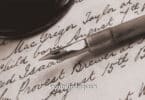It can be frustrating to finally locate a document you have been searching for a long time, one that gives you proof of an ancestor’s existence, or relationship to the generation before or after him or her, and then not be able to read it. Whether you find the original text and the handwriting is almost impossible to decipher, or you find a smudged, low-quality image of the document on microfilm, microfiche, or online, do not despair. You can still get the information you need from that document. These are some tips you can use to decipher the seemingly un-decipherable.
While there are some locations that will let you look at, and even touch ancient documents, those places are few and far between. The keepers of those documents are, naturally, concerned with maintaining the integrity of these valuable primary sources preserved from deep in history. You are far more likely to come across photographed images of these documents on microfilm or microfiche. The images on these mediums vary widely in quality, as their clarity depends on the actual handwriting on the documents, and who photographed them. Before the days of digital imaging with scanners and cameras on phones, which produce almost uniformly clear pictures, the photos of ancient documents were taken with 35 mm film, which requires just the right amount of distance and exposure to make the photos clear and readable. The person doing the photographing required a high degree of skill to make good images, and not every photographer was as skilled as the next.
Even with a crystal clear image, the actual document that was photographed may still be hard to read, thanks to the differences in ancient handwriting as compared to our own, as well as the natural neatness or sloppiness of the writer when putting pen to paper. Other times, when both sides of the paper were written on, one side can bleed into the other, creating a mishmash of shadow words on the ones you want to read. On very old paper, bits of it may have been torn off or fallen off over the years, particularly on wood paper, or linen or hemp paper that has been exposed to water and made fragile. The missing bits may take parts of words or even complete sentences with them. There are a variety of issues that may keep you from reading an ancient document at first glance.
There are some ways to overcome these challenges. For example, if you can get access to the original document that appears on an unreadable microfilm or microfiche, you can take a digital photo or scan of it yourself. Done properly, these images are virtually indistinguishable in appearance from the originals. If this is not possible, use a computer-controlled microfilm or microfiche reader that allows you to zoom in or out, and invert the image from positive to negative and back. You can make images that are too dark light enough to read, make faded images dark enough to read, and zoom in on hard to decipher handwriting to get a better look at the shape of the letters. Many archives are now moving toward the use of computer-controlled microfilm and microfiche machines, which makes your chances of finding them higher than it used to be.
If you have to get a reference librarian to request a copy of a document for you, because you find a reference to it, but it is not on-site, you can avoid being left to the mercy of their copying skills by asking for a digital copy be emailed to you. This will be a cleaner, crisper image than one obtained from a copy machine. If you get the image via email and it is still challenging to read, you can use your photo editing software to adjust color, contrast, and brightness to make reading the document much easier.
When you have an image as clear as you can get it, you actually have to read it. This may or may not be an easy task for you, depending on how familiar you are with old-fashioned and ancient styles of handwriting. Luckily, you will usually pick up on this pretty quickly with a little practice. The more ancient documents you read, the easier subsequent ones will be to read.
In fact, some ancient documents, such as deeds, contain such standard wording that reading them becomes almost second nature the more of them you discover. You can also get an idea of what type of record you are looking at by the words in it. For example, “rood,” which is an old unit of measurement, would not be found on a birth, death, or marriage record, but it may be found in a deed, will, or tax record.
A quick tutorial on ancient abbreviations, which you can find online with a simple Google search, will go a long way in helping you read these documents. Abbreviations were used liberally in old documents. In fact, people who lived two or more centuries before us used way more abbreviations than we use today. They might abbreviate just about anything. Look for commonly used abbreviations of legal words and names to help you navigate the wording of the document and discover its meaning.
A good technique is to transcribe the parts of the document that you can read onto a piece of paper, or type it into your computer. Once you have everything you are able to read in front of you in plain text with which you are familiar, with lines added to represent the words you can’t read on the document, you may be able to interpret the missing words just by placing them in the context of the rest of the document. Be sure to transcribe words you can only partially read, and write them down exactly as you find them. They may begin to make more sense once you see them in the document as a whole, on your word processing program.
Remember, everyone had different handwriting back then, just as they do today. Once you are familiar with one person’s writing, such as how they make certain letters and what abbreviations they like to use, you will soon be able to read anything they have written. However, ancient documents had many different authors. Once you’ve gotten used to one writer’s handwriting, you will soon have to learn the peculiarities of another one’s. It is just the nature of genealogy. After a while, it may become like solving a puzzle for you and become a fun challenge. After all, you are a puzzle solver by nature as a genealogist. Interpreting old handwriting is just another puzzle to solve. It can be enjoyable. Some genealogists who offer their services to others enjoy it so much, they make interpreting old handwriting their specialty. You may, too.






